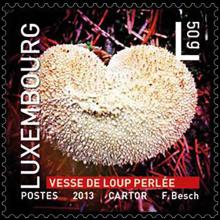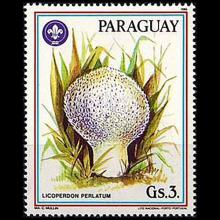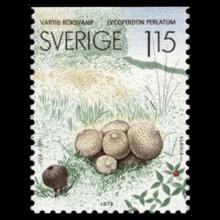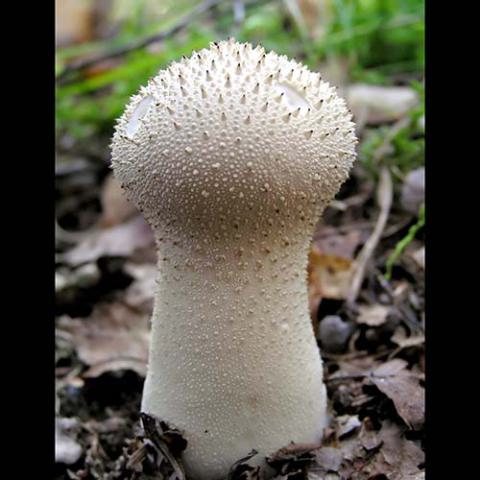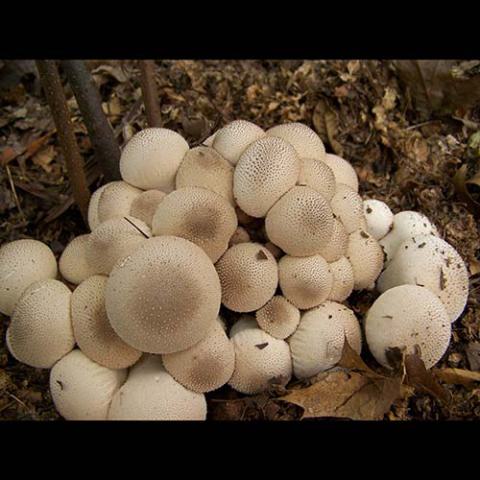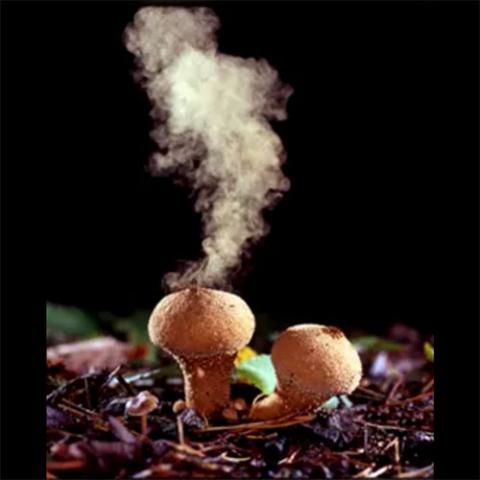NAMES
TAXONOMY
FUNGI ID
THERAPEUTIC
Luxembourg
Issued:
Stamp:
Lycoperdon perlatum
Paraguay
Issued:
Stamp:
Lycoperdon perlatum
Sweden
Issued:
Stamp:
Lycoperdon perlatum
Luxembourg
Issued:
Stamp:
Lycoperdon perlatum
Paraguay
Issued:
Stamp:
Lycoperdon perlatum
Sweden
Issued:
Stamp:
Lycoperdon perlatum
Luxembourg
Issued:
Stamp:
Lycoperdon perlatum
Paraguay
Issued:
Stamp:
Lycoperdon perlatum
Sweden
Issued:
Stamp:
Lycoperdon perlatum
Genus species (Animalia): Lycoperdon perlatum
Lycoperdon perlatum, popularly known as the common puffball, warted puffball, gem-studded puffball, wolf farts or the devil's snuff-box, is a species of puffball fungus in the family Agaricaceae. A widespread species with a cosmopolitan distribution, it is a medium-sized puffball with a round fruit body tapering to a wide stalk, and dimensions of 1.5 to 6 cm (5⁄8 to 2+3⁄8 in) wide by 3 to 10 cm (1+1⁄8 to 3+7⁄8 in) tall. It is off-white with a top covered in short spiny bumps or "jewels", which are easily rubbed off to leave a netlike pattern on the surface. When mature it becomes brown, and a hole in the top opens to release spores in a burst when the body is compressed by touch or falling raindrops.
Common puffball, releasing spores in a burst by compressing the body The puffball grows in fields, gardens, and along roadsides, as well as in grassy clearings in woods. It is edible when young and the internal flesh is completely white, although care must be taken to avoid confusion with immature fruit bodies of poisonous Amanita species. Lycoperdon perlatum can usually be distinguished from other similar puffballs by differences in surface texture. Several chemical compounds have been isolated and identified from the fruit bodies of Lycoperdon perlatum, including sterol derivatives, volatile compounds that give the puffball its flavor and odor, and the unusual amino acid lycoperdic acid. Extracts of the puffball have antimicrobial and antifungal activities.
Description
The fruit body ranges in shape from pear-like with a flattened top, to nearly spherical, and reaches dimensions of 1.5 to 6 cm (5⁄8 to 2+3⁄8 in) wide by 3 to 7 cm (1+1⁄8 to 2+3⁄4 in) tall. It has a stem-like base, and is whitish before browning in age. The outer surface of the fruit body (the exoperidium) is covered in short cone-shaped spines that are interspersed with granular warts. The spines, which are whitish, gray, or brown, can be easily rubbed off, and leave reticulate pock marks or scars after they are removed. The base of the puffball is thick, and has internal chambers. It is initially white, but turns yellow, olive, or brownish in age. The reticulate pattern resulting from the rubbed-off spines is less evident on the base.
In maturity, the exoperidium at the top of the puffball sloughs away, revealing a pre-formed hole (ostiole) in the endoperidium, through which the spores can escape. In young puffballs, the internal contents, the gleba, is white and firm, but turns brown and powdery as the spores mature. The gleba contains minute chambers that are lined with hymenium (the fertile, spore-bearing tissue); the chambers collapse when the spores mature. Mature puffballs release their powdery spores through the ostiole when they are compressed by touch or falling raindrops. A study of the spore release mechanism in L. pyriforme using high-speed schlieren photography determined that raindrops of 1 mm diameter or greater, including rain drips from nearby trees, were sufficient to cause spore discharge. The puffed spores are ejected from the ostiole at a velocity of about 100 cm/second to form a centimeter-tall cloud one-hundredth of a second after impact. A single puff like this can release over a million spores.
The spores are spherical, thick-walled, covered with minute spines, and measure 3.5–4.5 μm in diameter. The capillitia (threadlike filaments in the gleba in which spores are embedded) are yellow-brown to brownish in color, lack septae, and measure 3–7.5 μm in diameter. The basidia (spore-bearing cells) are club-shaped, four-spored, and measure 7–9 by 4–5 μm. The basidia bear four slender sterigmata of unequal length ranging from 5–10 μm long. The surface spines are made of chains of pseudoparenchymatous hyphae (resembling the parenchyma of higher plants), in which the individual hyphal cells are spherical to elliptical in shape, thick-walled (up to 1 μm), and measure 13–40 by 9–35 μm. These hyphae do not have clamp connections.
Edibility
Lycoperdon perlatum is considered to be a good edible mushroom when young, when the gleba is still homogeneous and white. They have been referred to as "poor man's sweetbread" due to their texture and flavor. The fruit bodies can be eaten after slicing and frying in batter or egg and breadcrumbs, or used in soups as a substitute for dumplings. As early as 1861, Elias Fries recommended them dried and served with salt, pepper, and oil. The puffballs become inedible as they mature: the gleba becomes yellow-tinged then finally develops into a mass of powdery olive-green spores. L. perlatum is one of several edible species sold in markets in the Mexican states of Puebla and Tlaxcala. The fruit bodies are appealing to other animals as well: the northern flying squirrel (Glaucomys sabrinus) includes the puffball in their diet of non-truffle fungi, while the "puffball beetle" Caenocara subglobosum uses the fruit body for shelter and breeding. Nutritional analysis indicates that the puffballs are a good source of protein, carbohydrates, fats, and several micronutrients. The predominant fatty acids in the puffball are linoleic acid (37% of the total fatty acids), oleic acid (24%), palmitic acid (14.5%), and stearic acid (6.4%).
The immature 'buttons' or 'eggs' of deadly Amanita species can be confused with puffballs. This can be avoided by slicing fruit bodies vertically and inspecting them for the internal developing structures of a mushroom, which would indicate the poisonous Amanita. Additionally, amanitas will generally not have "jewels" or a bumpy external surface.
The spores' surfaces have many microscopic spines and can cause severe irritation of the lung (lycoperdonosis) when inhaled. This condition has been reported to afflict dogs that play or run where the puffballs are present.
Reference: Wikipedia
Photos: Daniel Ullrich,Hamilton,National Park Service

